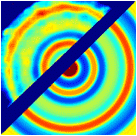Department of Physics and Astronomy: Publications and Other Research

Martin Centurion Publications
Document Type
Article
Date of this Version
8-2015
Citation
Published in Structural Chemistry (2015); doi: 10.1007/s11224-015-0650-4
Abstract
Electron diffraction is a valuable tool to capture structural information from molecules in the gas phase. However, the information contained in the diffraction patterns is limited due to the random orientation of the molecules. Additional structural information can be retrieved if the molecules are aligned. Molecules can be impulsively aligned with femtosecond laser pulses, producing a transient alignment. The alignment persists only for a time on the order of a picosecond, so a pulsed electron gun is needed to record the diffraction patterns. In this manuscript, we describe the alignment process and show the changes in the diffraction pattern as a result of alignment. Carbon disulfide, a linear molecule, was chosen as a model molecule for these experiments. We have also experimentally investigated the temporal evolution of the alignment and the dependence on the laser pulse intensity.


Comments
Copyright © 2015 Springer Science+Business Media New York. Used by permission.